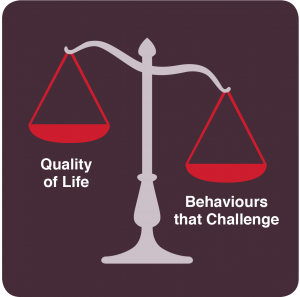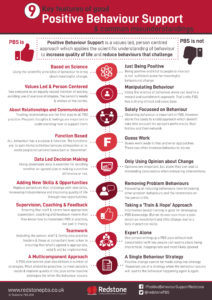More people are becoming aware of and are interested in Positive Behaviour Support (PBS). It is now included in a significant amount of national guidance both for adults and children. This is because of the growing evidence base of the effectiveness of PBS in increasing quality of life and reducing behaviours that are harmful for the person (which can lead to the use of restrictive practices including assessment and treatment units). Although people are more aware of PBS, many aren’t really sure what it is or how to do it effectively. There are sometimes significant misunderstandings based on experience of less than ideal application as well as the sharing of inaccurate information.
Over the last few years, at Redstone we have tried to clarify the key elements of PBS in various ways. So for those who are new to the area, asking ‘what is positive behaviour support’? there is some quick to read articles about PBS. In this blog we have pulled together many of the misunderstandings that we have come across and explored the reality of good PBS practice based on definitions outlined by experts in the field (Gore et al 2012).
Why should you care?
So why should you care? Why should you even read this? We often hear about an adult or a child being restricted due to their ‘behaviour’. I put ‘behaviour’ in parenthesis because in reality it is not the person’s behaviour that is the issue. It is really about the inability to meet their needs appropriately which causes the issues that lead to the person’s life becoming restricted and then to the use of restraints and medications. The families of these people and those of us who work with them know that while these measures may have appeared to keep the person ‘safe’ they have harmed the person – sometimes physically but always psychologically and emotionally. Whilst restrictive settings may talk about PBS and have PBS plans, the reality is that in the majority of these settings what’s called PBS is actually business as usual and not specific PBS. So, what is positive behaviour support?
What IS and what is NOT PBS
So, here’s our contribution to clarity around PBS, we’ve put it into an infographic so that it’s as clear as possible and each section has been discussed in more detail below.
PBS is Based on Science – its NOT Just Being Positive
Taking a positive approach to working with people is important. However, alone it is not sufficient to make the changes required to make the behaviour redundant.
PBS uses scientific principles of how behaviour works to bring together a range of information and data that will help to understand the person and their needs and thus help to understand the message behind a particular behaviour that may be perceived as challenging. The science behind PBS helps us to understand that almost all behaviours are learned, have a function (reason) and meet a need. The behaviour represents the best way that the individual has at that time to express what they need to gain or avoid.
PBS is Values Led and Person Centred – It’s NOT about Manipulating the Person’s Behaviour
PBS sees every person as a valued member of society and as such they have a right to be respected and treated with dignity. PBS must always involve the person where possible, or those who know them best, and the person should be at the centre rather than the service or school. Whilst it’s possible to use the scientific understanding of behaviour in isolation from a values and person centered approach, this leads to approaches based purely on reward and punishment instead of ethics, values and the functions of behaviour. This approach to manipulating behaviour is NOT PBS.
PBS is about Relationships – its NOT solely about Behaviour
Relationships should be at the centre of PBS. Developing and nurturing positive, trusting and rewarding relationships where each person is understood and communication (however this is achieved) is central. It is an approach where feelings and thoughts are key in the process of unlocking meaning and understanding how we can support someone in the most effective way. Without this relationship and trust – change will not be possible.
Although it’s not the sole focus, observable behaviour is an important focus because this is what we can see, and we will have more evidence about change if we can measure what we can see. However, this includes staff and carer behaviour as well as the behaviour of the person and it also includes looking at and measuring new skills, new experiences, not just behavioural incidents. Recording and monitoring behaviour may not seem like ‘normal life’ but sometimes we have to do extraordinary things to ensure that vulnerable people can access the quality of life we all enjoy.
PBS is Function based – it’s not based on Guesswork
All behaviour has a function or a purpose and meets a need, even if this does not seem obvious or logical to us, because a behaviour may appear to be harmful to the person or to others. There are only four key functions of behaviour;
- To meet a sensory need
- To gain items or activities that are preferred or wanted
- To gain social attention
- To avoid people, situations or tasks
The likelihood of specific behaviours occurring is influenced by things that have happened in the past, by events, experiences or responses that occur just prior to a situation and by the response that is received following the behaviour. This applies to all of us.
Plans that are based on anecdotal and subjective judgments often lead to a ‘trial and error’ approach that can make the situation much worse, result in damaging the relationships between the individual and those around them, escalate the behaviour and result in further isolation and exclusion for the person involved.
PBS is Data Led Decision Making – It’s NOT based on Subjective Opinion
To ensure that we know if plans are making a positive difference for the person, we need to ensure that we have objective information or data. Without this there are two risks;
- We stop implementing a plan because we aren’t sure if its working
- We keep on implementing a plan, even when it’s not working, but we don’t know this
When we put plans into place, we also need to know that they are being put into place properly by those around the person. We also need to make sure the team around the person has the same information, so they are part of the decision-making process, and if the person has the ability to understand and can be part of the decision making and planning process, they should be.
PBS is adding new skills and opportunities – It’s NOT about removing problem behaviour
PBS at its heart is about improving the quality of life for the person. By learning new skills, the person can meet their needs through behaviours that are not harmful to them or others. Often this is about learning new skills in communication, learning how to do things independently, being able to make choices, or having a better understanding of our emotions and how to manage them. Teaching new skills increases independence and self-determination and thus quality of life. By having new opportunities, the person’s life experiences expand, they have more interesting and stimulating activities to do. We all need this.
A focus on reducing behaviours and risks does not increase quality of life. In our experience focusing on reducing behaviours leads to increased restrictions and harm to the person. It can also lead to other problem behaviours, which then increases the negative perceptions of the person. This approach leads to a downward spiral for the person.
PBS is Supervision, Coaching and Feedback – It’s NOT taking a ‘train and hope’ approach
Classroom based training, whatever the academic level, is needed to gain information and knowledge about PBS and behavioural science. However, it is not sufficient alone to ensure that people have the skills necessary to put PBS into practice. Often organisations supporting or educating adults and children commission training and HOPE that participants will be able to apply all that knowledge. However, this is never the case with PBS, which requires a complex skill set. Behavioural science gives us guidance about how the skills for staff and professionals can be taught and learnt. This is called Behaviour Skills Training and ensures that anyone learning a new skill gains the right level of support to practice it effectively.
The Behaviour Skills training Model identifies that trainees need;
- Information about how to do something
- Observation of someone else modelling the practice
- Observation and feedback on their own practice by an experienced person
- Further observation after changes in practice from feedback
Without on-going guidance and support to enhance our practice, we are left adrift and will often discontinue or give up, resort to default approaches which are quicker and less of a struggle, or we lose focus. We need support to help us continue to develop our skills.
PBS is Teamwork – It’s NOT expert alone
One person writing up a PBS plan without real consultation with key people will lead to plans being impractical, inappropriate and most likely ignored. This will merely result in low morale for family, the person and all those working with the person and thus nothing will change. However, if we ensure that everyone is involved, the person, their family, the staff around them then great things can be accomplished with and for the person. Everyone has important knowledge and information which can continue to support effective plans which have real impact.
PBS is A Multi-Component Approach – It’s NOT a Single Behaviour Strategy
Positive change cannot be made by using one strategy. Repeated use of a strategy when the behaviour occurs will lead to the behaviour happening again and again. This sort of strategy may manage the impact of the behaviour when it occurs, but it will not result in increased quality of life and positive change for the person. A PBS intervention plan should have a number of strategies. The majority should be proactive, to meet people’s needs, teach new skills, introduce new opportunities and improve quality of life. There will also likely be some reactive strategies for when the behaviour occurs. This needs to be reviewed regularly and is often a lifelong approach as situations, circumstances and needs change throughout life. Other evidence-based approaches may also be appropriate such as 1:1 therapy that can be positive and helpful for the person.
As a whole approach, the combination of all of these elements and parts is one of the strengths of PBS.
Conclusion
Hopefully the information included in this blog also helps to some useful information on ‘what is positive behaviour support’ and highlight that having a PBS plan, however well written, does not mean you have PBS in practice. There is much more to it.
Redstone Tip
Using the items on the left of the infographic as a checklist, check whether the services provided to you and your family or the services you provide are meeting the key elements of good PBS.
 Click here for PBS Awareness E-learning
Click here for PBS Awareness E-learning
© Redstone PBS 2020
Author
 Kate Strutt – Director of Redstone PBS and Clinical Psychologist. Kate has over 20 years’ experience of working with adults and children with intellectual disabilities and those who are autistic, both within statutory services and the independent sector. Kate is registered with the Health and Care Professions Council. Bsc Psychology, D.Clin Psyc, MSc Applied Behaviour Analysis.
Kate Strutt – Director of Redstone PBS and Clinical Psychologist. Kate has over 20 years’ experience of working with adults and children with intellectual disabilities and those who are autistic, both within statutory services and the independent sector. Kate is registered with the Health and Care Professions Council. Bsc Psychology, D.Clin Psyc, MSc Applied Behaviour Analysis.









